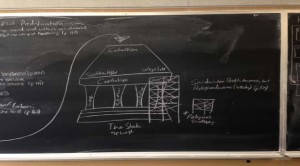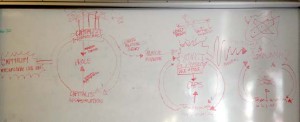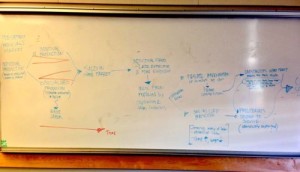by Christopher Herring, Sociology
Teaching Effectiveness Award Essay, 2015
Problem: While most professors have converted to Power Point, Sociology Professor Michael Burawoy remains wedded to the blackboard and diagrams relentlessly — sketching the most complex concepts of sociology’s grand theorists into compact, dynamic, and memorable depictions. However, one of the problems I faced as a GSI was that students were often unable to translate the signs, symbols, and pathways of each diagram, and when students did copy and decipher the diagrams properly their weekly reading responses would often be a mere verbal re-hashing of Burawoy’s sketches. Therefore, a primary task became figuring out a way to get my students to take these illustrations as the starting point for discussion rather than the end-point.
Teaching Strategy: As soon as I realized how responsive the students were to Burawoy’s own diagramming, yet how hesitant they were to extend or elaborate such drawings in section, I started having students submit diagrams of the course’s key theories every other week in place of a writing response. They were both more encompassing and more detailed than the professor’s. I immediately sought to integrate these individual sketches into our section conversations. I’d also been looking for a way to salvage small group discussions, the only component of my mid-semester evaluations that had received mixed reviews with a 50/50 split among students on their effectiveness.
Rather than bringing the “best of” contributions to the table as I’d often done with online weekly responses, I instead created a small group exercise with the sketches. All the students were assigned a single theory to sketch and would bring in individual sketches to section. They would divide into small groups, and after quickly deciding a general structure to work from, would begin mapping out each theory, layering their contributions onto a single collective image on the blackboard. They would insert quotes and citations, argue over the direction of causal arrows, and improvise new distinctions between concepts. At the end of each section we would have four distinct theoretical drafts on the board, and students would present, compare, and discuss contradictions, missing links, and shifts in emphasis between the representations. After, I would photograph the collective sketches and load them onto the bSpace resource page. Over the course, we collectively drew out seven theories including Marx’s stages of capitalist crisis, Lenin’s theory of transition to communism, and Weber’s theory of the rise of the spirit of capitalism among others (see images below).
Assessment: Having the students collectively sketch out social theory immediately ratcheted up both the level of participation and the relevance of small group work. Not only were discussions more boisterous, they were more nuanced and pointed, forcing the students to return to the text to clarify conflicting interpretations that they were about to inscribe upon the board. My teaching evaluations were full of comments on how the diagramming exercise was the best part of section and that the collective images were the most useful resource from section in writing their final exams. Upon the students’ suggestion, we spent our final section before the exam reviewing the group drawings from the entire year. Most importantly the students expressed an ever-growing confidence and clarity in articulating complex theories of macro-social change through sketching out these conceptual relationships, together.
Weber’s conception of modern Western rational bourgeois capitalism c. 17th century–late 19th century, when the religious scaffolding was still up and before the installation of the iron cage. From The Protestant Ethic (1905).
Durkheim’s theory of social evolution: from mechanical solidarity (MS) to organic solidarity (OS) through the division of labor (DL). From The Division of Labor in Society (1893).
Lenin’s theory of transition: capitalism to the dictatorship of the proletariat to communism. From The State and Revolution (1917).
Marx and Engels’ development of capitalist crisis. From Engels’ Socialism Utopian and Scientific (1880).





